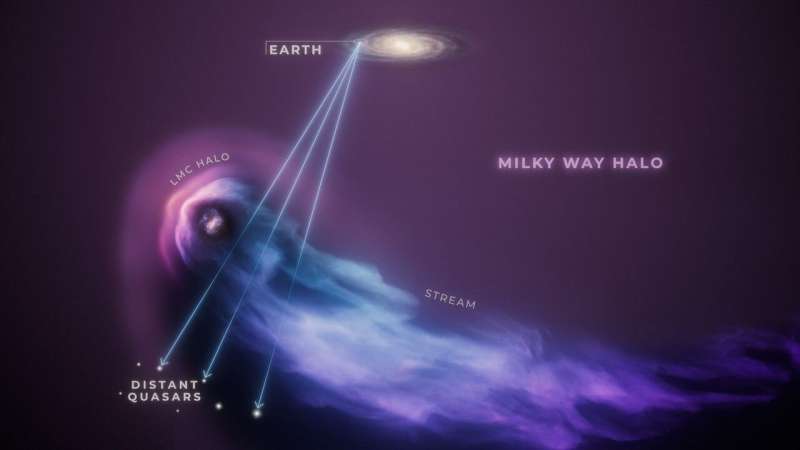
A story of survival is unfolding at the outer reaches of our galaxy, and NASA’s Hubble Space Telescope is witnessing the saga.
The Large Magellanic Cloud, also called the LMC, is one of the Milky Way galaxy’s nearest neighbors. This dwarf galaxy looms large on the southern nighttime sky at 20 times the apparent diameter of the full moon.
Many researchers theorize that the LMC is not in orbit around our galaxy, but is just passing by. These scientists think that the LMC has just completed its closest approach to the much more massive Milky Way. This passage has blown away most of the spherical halo of gas that surrounds the LMC.
Now, for the first time, astronomers have been able to measure the size of the LMC’s halo—something they could do only with Hubble. In a new study, available on the preprint server arXiv and to be published in The Astrophysical Journal Letters, researchers were surprised to find that it is so extremely small, about 50,000 light-years across. That’s around 10 times smaller than halos of other galaxies that are the LMC’s mass. Its compactness tells the story of its encounter with the Milky Way.
“The LMC is a survivor,” said Andrew Fox of AURA/STScI for the European Space Agency in Baltimore, who was principal investigator on the observations. “Even though it’s lost a lot of its gas, it’s got enough left to keep forming new stars. So new star-forming regions can still be created. A smaller galaxy wouldn’t have lasted—there would be no gas left, just a collection of aging red stars.”
Though quite a bit worse for wear, the LMC still retains a compact, stubby halo of gas—something that it wouldn’t have been able to hold onto gravitationally had it been less massive. The LMC is 10 percent the mass of the Milky Way, making it heftier than most dwarf galaxies.
“Because of the Milky Way’s own giant halo, the LMC’s gas is getting truncated, or quenched,” explained STScI’s Sapna Mishra, the lead author on the paper chronicling this discovery. “But even with this catastrophic interaction with the Milky Way, the LMC is able to retain 10 percent of its halo because of its high mass.”
A gigantic hair dryer
Most of the LMC’s halo was blown away due to a phenomenon called ram-pressure stripping. The dense environment of the Milky Way pushes back against the incoming LMC and creates a wake of gas trailing the dwarf galaxy—like the tail of a comet.
“I like to think of the Milky Way as this giant hairdryer, and it’s blowing gas off the LMC as it comes into us,” said Fox. “The Milky Way is pushing back so forcefully that the ram pressure has stripped off most of the original mass of the LMC’s halo. There’s only a little bit left, and it’s this small, compact leftover that we’re seeing now.”
As the ram pressure pushes away much of the LMC’s halo, the gas slows down and eventually will rain into the Milky Way. But because the LMC has just gotten past its closest approach to the Milky Way and is moving outward into deep space again, scientists do not expect the whole halo will be lost.
Only with Hubble
To conduct this study, the research team analyzed ultraviolet observations from the Mikulski Archive for Space Telescopes at STScI. Most ultraviolet light is blocked by the Earth’s atmosphere, so it cannot be observed with ground-based telescopes. Hubble is the only current space telescope tuned to detect these wavelengths of light, so this study was only possible with Hubble.
The team surveyed the halo by using the background light of 28 bright quasars. The brightest type of active galactic nucleus, quasars are believed to be powered by supermassive black holes. Shining like lighthouse beacons, they allow scientists to “see” the intervening halo gas indirectly through the absorption of the background light. Quasars reside throughout the universe at extreme distances from our galaxy.
The scientists used data from Hubble’s Cosmic Origins Spectrograph (COS) to detect the presence of the halo’s gas by the way it absorbs certain colors of light from background quasars. A spectrograph breaks light into its component wavelengths to reveal clues to the object’s state, temperature, speed, quantity, distance, and composition. With COS, they measured the velocity of the gas around the LMC, which allowed them to determine the size of the halo.
Because of its mass and proximity to the Milky Way, the LMC is a unique astrophysics laboratory. Seeing the LMC’s interplay with our galaxy helps scientists understand what happened in the early universe, when galaxies were closer together. It also shows just how messy and complicated the process of galaxy interaction is.
Looking to the future
The team will next study the front side of the LMC’s halo, an area that has not yet been explored.
“In this new program, we are going to probe five sightlines in the region where the LMC’s halo and the Milky Way’s halo are colliding,” said co-author Scott Lucchini of the Center for Astrophysics | Harvard & Smithsonian. “This is the location where the halos are compressed, like two balloons pushing against each other.”
More information:
Sapna Mishra et al, The Truncated Circumgalactic Medium of the Large Magellanic Cloud, arXiv (2024). DOI: 10.48550/arxiv.2410.11960
Journal information:
Astrophysical Journal Letters
,
arXiv
Provided by
NASA
Hubble sees aftermath of galaxy’s scrape with Milky Way (2024, November 14)
retrieved 15 November 2024
from https://phys.org/news/2024-11-hubble-aftermath-galaxy-milky.html
part may be reproduced without the written permission. The content is provided for information purposes only.